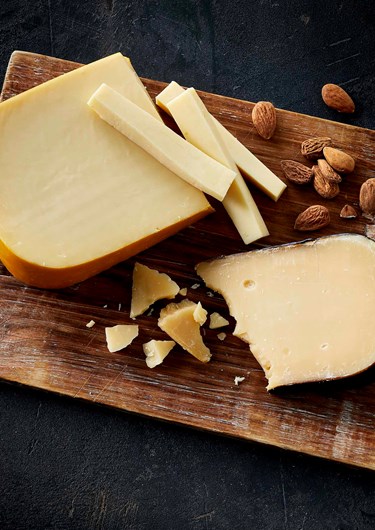
Gouda Cheese
What is Gouda?
Celebrated in a wide span of culinary cultures, Gouda has its roots in the southern regions of the Netherlands. Typically made from cow’s milk, this semi-hard cheese is characterized by its aromatic and caramel-like flavor combined with its dense and springy texture. Hints of nuts with sweet and creamy notes embrace your palate in a graceful sensation and, depending on the age, the finish ranges from smooth to sharp.
Although categorized in multiple types, the essence of Gouda remains essentially the same throughout all of its variations. The flavors are imparted, to a great extent, from the natural pastures on which the cattle graze, and the development of salt crystals gives it a crumbling texture as the cheese ages.
Distinct in character, diverse in style, Castello Gouda cheese conveys a full-bodied and rich flavor, embodying versatility.
How Gouda is made
Immense attention to detail goes into the production of Gouda, all the way from the milking parlor to the creamery, with quality being ensured through comprehensive testing.
The process begins by pouring fresh milk into a large vat. Depending on the type of Gouda, the milk is either raw or pasteurized. Natural bacteria and rennet are then added to coagulate the milk and form the curd. When firm, the curd is separated and placed in a mold. The cheese obtains its characteristic density from being compressed by weights, and is then ready for brining. The salt from the brine slows down any unwanted bacterial activity and promotes the iconic Gouda flavor. A natural cheese coating is applied to help shield against contamination, before it is finally set to age. A steady lukewarm temperature encourages the flavors to flourish while simultaneously allowing the cheese to release moisture, resulting in a dense and consistent texture. Gouda can spend anywhere from four weeks to over 12 months maturing, resulting in vastly different outcomes.
Gouda comes in both pasteurized and unpasteurized variants. Similarly, production calls for either vegetarian or non-vegetarian rennet, resulting in cheeses suited for most preferences. Always be sure to check the label when in doubt.
Substitutes for Gouda
By and large, sweet and buttery flavors are commonplace among a broad array of cheeses, and finding one that shares similar traits to those of Gouda should not take long.
Comparable in both appearance and taste, Edam is another Dutch semi-hard cheese. It is characterized by its nutty and sweet flavor, and its dense texture. Made from cow’s milk, the flavors and aromas sharpen as it ages.
A sharper take on the Gouda flavor, Cheddar offers a similar density and texture. Less sweet, with stronger notes of butter and hazelnut, Cheddar works as a competent alternative to Gouda.
Curious about the world of cheese? Here's everything you need to know about how to store, serve and cut cheese!







